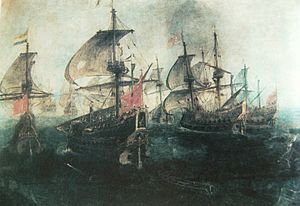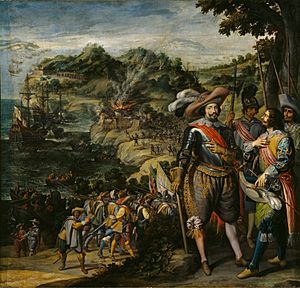Battle of Gibraltar (1621) facts for kids
Quick facts for kids Battle of Gibraltar |
|||||||
|---|---|---|---|---|---|---|---|
| Part of the Eighty Years' War | |||||||
 The Battle of Gibraltar, by Enrique Jácome y Brocas, c. 1630 |
|||||||
|
|||||||
| Belligerents | |||||||
| Commanders and leaders | |||||||
| Fadrique de Toledo | Willem Haultain de Zoete | ||||||
| Strength | |||||||
|
|
||||||
| Casualties and losses | |||||||
| None |
|
||||||
The Battle of Gibraltar happened on August 10, 1621. It was a naval battle during the Eighty Years' War. This war was fought between the Spanish Empire and the Dutch Republic.
A fleet of ships from the Dutch East India Company was sailing. These ships were protected by a group of warships led by Willem Haultain de Zoete. They were stopped and defeated by nine Spanish ships. These Spanish ships were part of Spain's Atlantic fleet. They were led by Fadrique de Toledo. The battle took place as the ships passed through the Strait of Gibraltar.
The Twelve Years' Truce between Spain and the Dutch Republic had just ended. Spain wanted to strike a big blow against Dutch trading ships. These ships were very important in the Mediterranean Sea. Spain tried to gather a large fleet in the Bay of Gibraltar. But several Spanish admirals and their groups of ships could not join Toledo's fleet in time. So, Toledo faced the Dutch with only nine ships. Four days later, a large Dutch trading fleet was spotted. It had more than 50 ships. Twenty of these were warships, and the rest were merchant ships carrying goods.
Toledo's powerful lead ship, the Santa Teresa, fought many Dutch ships. It even set two of them on fire. Smaller Spanish ships captured two Dutch ships and burned another. The Santa Teresa eventually lost its main mast and had to be pulled away. The Dutch ships retreated with most of their valuable merchant ships. They had lost seven ships in total. The Spanish ships returned to Cádiz. They had some damage but did not lose any of their own ships.
Why the Battle Happened
The Eighty Years' War was a long fight. It was between the Spanish Empire and the Dutch Republic. The Dutch had rebelled against Spanish rule. There was a twelve-year break in the fighting called a truce. During this truce, Spanish and Dutch ships sometimes worked together. They fought against Barbary pirates, who were sea robbers. They captured many pirate ships near Gibraltar.
In 1621, the truce ended. The Dutch started attacking by sea. A large fleet of Dutch and Danish ships entered the Mediterranean Sea. Gaspar de Guzmán, Count-Duke of Olivares, who was in charge of Spain's foreign policy, decided to fight back. Spain wanted to stop the important trade of the Dutch East Indies Company. Philip IV of Spain agreed with this plan.
Spain learned that a group of at least twenty Dutch ships was coming. These ships were from Venice and would pass through the Strait of Gibraltar. The Dutch ships would be well-armed and have strong escorts. So, Spain needed to gather many ships to fight them.
The best Spanish naval force was the Armada del Mar Océano. It had nine ships led by Don Fadrique de Toledo. These ships were supposed to meet other Spanish ships in Lisbon. But many ships were not ready in time. They lacked supplies and guns. This was due to problems with Spain's supply system.
So, Don Toledo's fleet was smaller than planned. His lead ship was the Santa Teresa. It was one of the strongest galleons in Europe. He also had six smaller ships and two pataches. Pataches were small, fast ships used for scouting and messages. This force was smaller than what was needed to fight the Dutch fleet. But Toledo, a famous admiral, decided to attack anyway. On August 6, he learned that more than 26 Dutch ships were near Málaga. They were getting ready to pass through the Strait of Gibraltar.
The Spanish leaders held a meeting. They decided to attack right away. They thought smaller Spanish groups might be on their way to meet them. They feared these groups might be defeated if they met the Dutch alone. So, the Spanish sailed into the Strait. They anchored in the Bay of Algeciras on August 8. The next day, two suspicious ships were seen from the fort of Ceuta. The Spanish squadron sailed to investigate. They soon saw the Dutch fleet. The Spanish watched the Dutch ships for the rest of the day and through the night.
The Battle Begins
The Dutch fleet arrived in two groups. One group had 24 ships in a formation. The other group had about seven scattered ships. About twelve strong Dutch warships were protecting the merchant ships. These warships were led by Admiral Willem Haultain de Zoete. Two of them were said to be very large.
The Dutch ships formed a crescent shape. Their plan was to avoid fighting if possible. They wanted to focus on protecting their valuable merchant ships. They were told not to fire unless attacked. The Dutch ships were in a better position because of the wind. This meant Toledo could choose whether to attack or not.
One historian, Agustin González, believed the six smaller Spanish galleons were not as strong as the twelve Dutch escort ships. The most important ship in the battle was the Spanish lead ship, Santa Teresa. It was much bigger and more powerful than any other ship on either side. The Spanish sailed towards the Dutch. They hoped to break up the Dutch formation. Then they could use their ships' better speed and turning ability.
First, the Santa Teresa fired a warning shot. It demanded that the Dutch surrender. Admiral Haultain's fleet immediately fired back. The Dutch ships fired from a medium distance. But the Santa Teresa waited until it was very close to the Dutch ships before firing. When the Spanish fired their cannons all at once, it caused "horrible effects" to those watching. This caused so much damage that the Dutch ships retreated.
The Santa Teresa then sailed right through the Dutch formation. It fired in all directions. It also took many hits in return. One Spanish ship, led by Don Alonso de Mujica, attacked and captured a Dutch warship. Another Spanish ship, the Santa Ana, did the same. Even a small Spanish patache, led by Captain Don Domingo de Hoyos, bravely fought a Dutch ship.
The Spanish lead ship broke completely through the Dutch formation. It then turned back towards the convoy. Its close-range fire set at least one Dutch ship on fire. The fighting was so close that the fire even spread to the Santa Teresa. It had to pull away to put out the flames. Then it returned to fight the burning Dutch ship. It stayed on the side where the wind would blow the flames away from it.
Many Dutch ships fired at the Spanish lead ship. Even though it was big and strong, the Santa Teresa was badly damaged. At least two of its masts fell down. With the Santa Teresa out of the main fight and the Dutch ships fleeing, the remaining Spanish ships pulled back. The battle ended around 3:00 pm.
Spain had a better outcome in terms of losses. They had sunk or burned five enemy ships. They also captured two more. The Spanish did not lose any ships. The Santa Teresa was the most damaged. It could still fight but could not move well without its masts. Don Luis de Noroña, a captain in Ceuta, watched the battle. He sent supplies and a surgeon to help. He also congratulated Toledo. He said Toledo had bravely fought so many ships with so few. The Spanish ships then returned to Cádiz.
What Happened After
Toledo was slightly hurt by a piece of wood, but he got better. He continued to have a successful career. Later, he led a naval trip to Brazil. There, he recaptured Bahia from the Dutch. The Spanish king, Philip IV, was very pleased. He rewarded the brave fighters with gifts and money. Toledo was made captain general of Portugal.
A painter named Enrique Jácome y Brocas was asked to create paintings of the battle. One of these paintings is now in the Naval Museum of Madrid. The Dutch also had a painting made to remember the battle.
This battle made the Dutch realize they needed stronger ships. They started adding more and heavier guns to their merchant ships. They also began to use stronger escorts. Spanish ships based in Ostend also started attacking Dutch shipping in the North Sea. They were helped by the Dunkirkers, who were privateers working for Spain. From January 1622, more and more Dutch ships were captured. The Dutch were also forced out of South America, Guayaquil, and Puerto Rico. At the same time, Spain almost completely cleared the Barbary pirates from the Mediterranean Sea. Because of these successes, the Spanish king was called "the Great."
|
See also
 In Spanish: Batalla de Gibraltar (1621) para niños
In Spanish: Batalla de Gibraltar (1621) para niños



